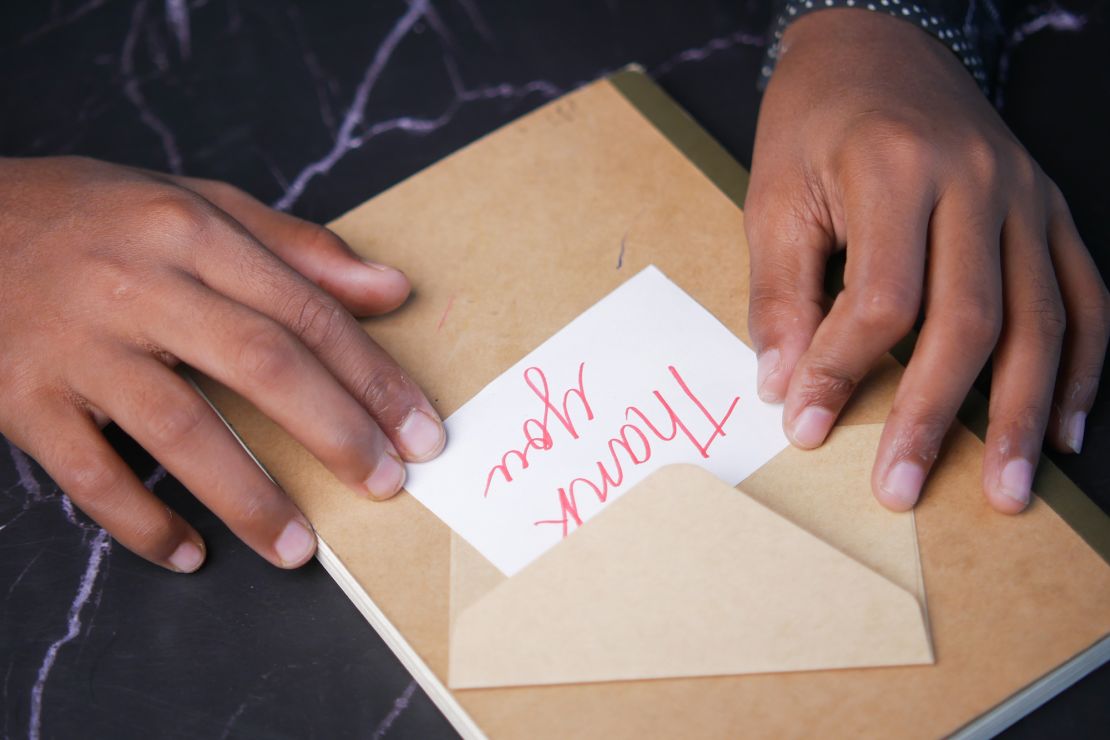Editor’s note: Shift Your Mindset is a new series from CNN’s Mindfulness, But Better team. We talk to experts about how to do things differently to live a better life.
Gratitude gets credited with making improvements in just about every life sphere, including benefiting decision-making, self-esteem and stress reduction and boosting cardiovascular health, immunity and sleep. You don’t have to look far to find countless recommendations for a gratitude practice as a key to happiness.
But is making a daily list of what you’re thankful for really the panacea it’s cut out to be? Researcher Sonja Lyubomirsky, distinguished professor of psychology at the University of California, Riverside, says the facts of the matter are not so straightforward.

It’s true that encouraging gratitude can increase happiness, but studies have shown that not everyone benefits from gratitude practices such as counting your blessings — and some people might actually fare worse. Marshaling her decades of research in the positive psychology field, Lyubomirsky, author of the best-selling “The How of Happiness” and “The Myths of Happiness,” shares insights on how gratitude practices work — and when they backfire.
This conversation has been edited and condensed for clarity.

CNN: In “The How of Happiness,” you call gratitude a “metastrategy for achieving happiness.” How does it work?
Sonja Lyubomirsky: Gratitude bolsters well-being by redirecting people’s attention, reframing their interpretations and coloring their memories toward positivity. Research has shown that gratitude can effectively neutralize negative emotions. It’s hard to feel jealous, resentful, angry or anxious when you’re also feeling grateful.
In a larger sense, gratitude also highlights a big-picture vantage point that helps you cope with adversity. For example, if someone’s house burns down, that person could focus?on the fact that their family survived?to help mitigate the pain of everything lost. Gratitude helps you deal with challenges and stressors in your life.
CNN: You write that part of why gratitude can be helpful is because it disrupts “hedonic adaptation.” What do you mean?
Lyubomirsky: Hedonic adaptation is our remarkable capacity to adjust rapidly to any new circumstance or event. It’s the reason why the boost we feel when we gain something good in life is usually short-lived. Gratitude helps us interrupt hedonic adaptation. To be grateful is the opposite of taking good stuff for granted.
CNN: What does research tell us about engaging in gratitude as a practice?
Lyubomirsky: The correlation between happiness and gratitude has been well-documented. Randomized, controlled studies have also demonstrated causation — that well-being and happiness increase for people when they’re prompted to express gratitude in different ways. We need more preregistered studies, we need bigger studies, but I’m pretty confident in that finding.
CNN: If happiness and well-being are the goals, what does an effective gratitude practice look like?
Lyubomirsky: That depends on the person. What works is whatever works best for you at that time in your life. Some people are very verbal. For them, finding a gratitude buddy to talk with might work best. If you’re going through a rough period, maybe the best way to practice gratitude is by spending time with friends and family and discussing what you appreciate.
Some people love writing, so thank-you letters, whether they send them or keep them private, might be helpful. Others keep a gratitude journal. One study found that expressing gratitude by composing a narrative or a letter is more powerful than just writing a list. There are lots of nuances, but the goal is to find a practice that fits with who you are at this moment.

CNN: You mention that introducing a visitor to the things, people and places that you love can increase gratitude. How does that work?
Lyubomirsky: Sharing your world with others helps you see the ordinary details of your life through new eyes, in a fresh way, making you appreciate them as though you were experiencing them for the very first time.
I live in Santa Monica and have an incredibly beautiful view of the ocean. I have adapted to it, but if a visitor comes and gasps, “Oh my God!” that might make me go from a 60% level of appreciation of the view to 80%. Spending time with children can help with this, too. They see the world in such a vibrant, excited, new way.
CNN: Is it possible to overdo a gratitude practice?
Lyubomirsky: If the goal is increasing happiness, yes. Gratitude interventions may be detrimental when administered too frequently. A study found differences between participant groups based on how frequently they wrote down five things for which they were thankful.
Students were randomly assigned to count their blessings once per week or three times per week, or to a wait-list control. Participants who counted their blessings once a week showed significant improvements in well-being, but those who did so three times a week showed either no benefit or slight decreases in well-being.
My interpretation was that maybe three times a week was too much. Perhaps people got bored or the activity became a chore or lost its meaning.
CNN: Could a gratitude practice actually cause harm?
Lyubomirsky: There are circumstances in which a gratitude practice can backfire. Early in my career, I heard from mental health professionals who expressed concern that using gratitude exercises might worsen the health of their depressed clients. I was very interested in that, so I did a study with depressed college students. So many participants reported getting less happy that I had to stop the study. Some reported feeling embarrassed or ashamed about receiving whatever help or kindness they’d included in their gratitude list. Others said they had trouble finding things to be grateful for, which made them feel worse about themselves and their lives.
How to get help
Help is available if you or someone you know is struggling with suicidal thoughts or mental health matters.
In the US: Call or text 988, the Suicide & Crisis Lifeline.
Globally: The International Association for Suicide Prevention and Befrienders Worldwide have contact information for crisis centers around the world.
I talked with a clinician who works with severely depressed teenagers in Canada about how one risk factor of suicidality is feeling that you’re a burden on your friends and family — that things would be easier for them if you were gone. We haven’t yet researched this, but I imagine asking people who are already feeling that way to think about all the different ways that their friends or family have helped and supported them over the years might make them feel even more of a burden.
Just generally, if I asked you to count your blessings every day for 10 days, it might be hard for you to keep coming up with things to be grateful for. That might lead you to conclude maybe you aren’t that fortunate in life.
CNN: What advice do you have for avoiding pitfalls while engaging in a gratitude practice?
Lyubomirsky: Use your intuition. Do your own me-search. If you’re engaging in a practice and you find yourself feeling less positive or less connected, then stop and try something else. Be cognizant of some of the factors we’ve discussed. Are you finding it hard to think of things to be grateful for? Is keeping a gratitude journal making you feel embarrassed, ashamed or like more of a burden? Has the practice become just a chore? Then switch it up. Maybe take a break or express gratitude in a new way.
And if your goal is happiness, keep in mind that gratitude is one of hundreds of activities you can do to be a happier person, to flourish more. Others include performing acts of kindness and spending time savoring the moment. Practicing gratitude is just one strategy.
Clarification: This story has been updated to reflect that practicing gratitude in coping with adversity is an internal process.
Jessica DuLong is a Brooklyn, New York-based journalist, book collaborator, writing coach and the author of “Saved at the Seawall: Stories From the September 11 Boat Lift” and “My River Chronicles: Rediscovering the Work That Built America.”



